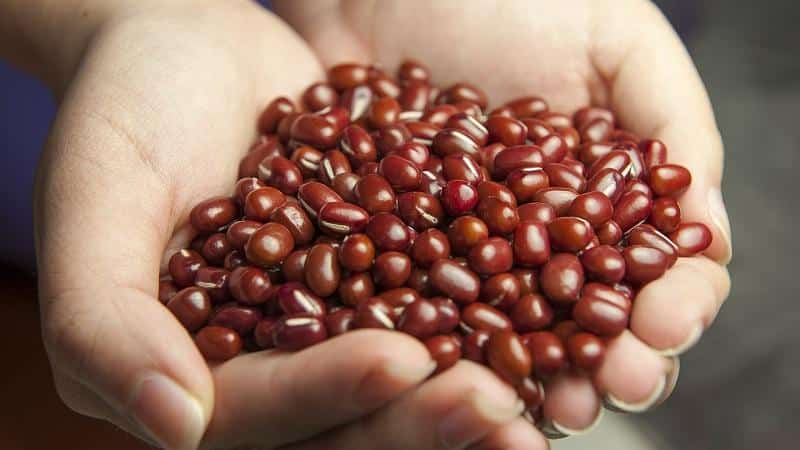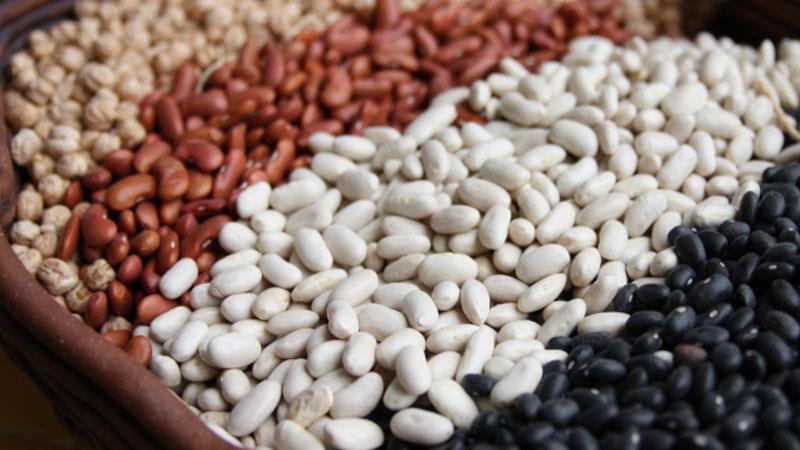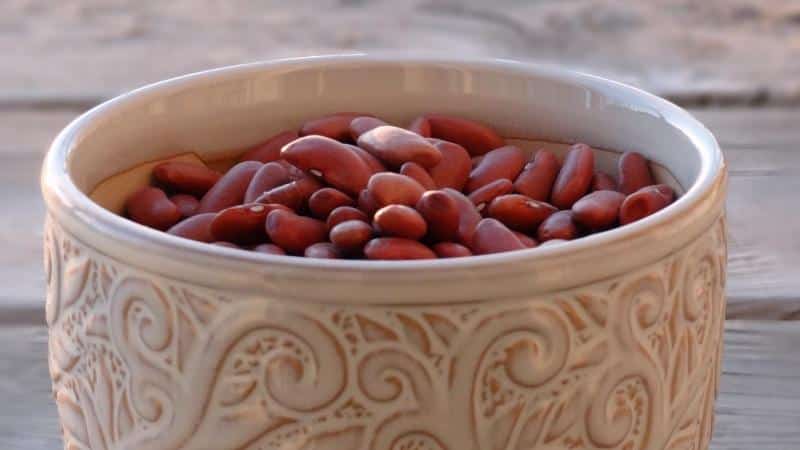How and when to plant red beans for a better harvest
Beans are considered one of the most ancient and valuable legumes. It supplies protein in its pure form to the body. The homeland of red beans is South America. Red beans are richer in chemical composition than other varieties, and are among the top ten healthiest vegetables. The body absorbs 75% of the proteins from its beans.
Description and characteristics
Depending on the characteristics and method of consumption, beans are divided into shelled, semi-sugar and sugar. Red beans are shelled beans.
It is an annual climbing plant with beautiful flowers, long pods and bright red fruits. Red kidney beans are crescent shaped. Color - from burgundy to variegated pink. It has the densest shell, tender, slightly oily flesh with a pleasant nutty taste.
If agrotechnical conditions are observed, it gives a good harvest.
It is known that beans can replace meat. By consuming it in large quantities, you will enrich your body in a short time vitamins group B and fiber.
Reference. 100 g of cooked beans per day provides the body with all the microelements it needs.
Red beans contain vitamins B, C, H and PP and almost all the minerals necessary for humans: calcium and potassium, copper, manganese, magnesium and zinc, iron, cobalt, nickel and aluminum, phosphorus and sodium.
The calorie content of red beans is about 310 kcal per 100 g of product.
The benefits and harms of red beans for the body
Raw beans contain toxic substances, so they must be cooked. At the same time, red beans have the highest concentration of such substances. In its raw form, it causes diarrhea and, in rare cases, serious poisoning.
It should be used with caution by people with gastrointestinal problems., especially in the acute stage. And for gout, gastritis, colitis, ulcers and cholecystitis, it is included in the list of prohibited foods.
It is recommended to give beans to children with caution and only after three years. Beans increase gas formation and promote flatulence, which causes cramps and bloating in a small child. In the first years of life, the baby may experience digestive problems as a result of eating beans, and he will suffer from prolonged constipation.
Pregnant women and the elderly should not indulge in bean dishes.
Eating beans is beneficial for women. Many components of this product help maintain the beauty of skin, hair and nails.
It is believed that red beans are the richest in antioxidants, which prevent aging, protect the cardiovascular system, and help prevent cancer. In terms of their quantity, it can compete with currants.
For those following a vegetarian diet, it is an alternative source of protein.
The benefits of canned beans are quite high. With this form of processing, it retains up to 70% of vitamins and up to 80% of minerals compared to fresh beans.

When losing weight
Scientists have proven that beans contain enzymes that slow down the process of alpha-amylase synthesis.This substance affects the breakdown of polysaccharides, resulting in the release of monosaccharides that enter the blood directly from the intestines. With a lack of monosaccharides, carbohydrates are poorly broken down.
Eating red beans reduces appetite.
It does not have a characteristic odor or unpleasant taste, which makes it possible to prepare various dishes from it.
The most common way to use it when losing weight is bean broth, which should be drunk during lunch and dinner.
How to grow
Beans love slightly alkaline or neutral soil. To do this, wood ash is added to the soil before planting. This is the most heat-loving legume crop and tolerates drought well. In this regard, the minimum growing temperature is 10-12°C, the maximum is 37°C. 25-30°C is considered optimal.
The plant is very sensitive to frost, at a temperature of -1°C it dies.
Landing
The planting area should be well lit, not windy and not swampy. You can fertilize the soil with humus or rotted compost (6-10 kg per 1 m²). Before planting, it is better to soak the planting material in water or a weak solution of potassium permanganate for additional disinfection (enough for one day).
Important! During the soaking period, you should change the water several times.
It is recommended to sow the seeds at a distance of 15 cm from each other to a depth of 5-6 cm. After planting, just water with warm water.
Feeding and watering
If the plants develop poorly, they can be fed with ammonium nitrate and potassium salt (2-3 g each), superphosphate (4-6 g per 1 m²). After three weeks, a second feeding should be done, but without nitrogen.
In dry weather, plants are watered until 4-5 true leaves form. Watering very important during fruit set.
Harvesting
Harvest after the pods have fully ripened, when they have already dried. You should trim the shoots at the surface of the soil, tie them into bunches, then hang them in a dry, well-ventilated area (for example, a barn or attic).
After half a month, when the seeds are dry, they are husked and placed in glass containers, closing with a lid.
The roots of the plant are left in the ground: as they decompose, they saturate the ground with nitrogen.

Prevention of diseases and pests
This crop is most often damaged by garden and cabbage cutworms. They lay eggs on the lower parts of the bush. Then their larvae eat the plant. To prevent their appearance in the fall, you should dig the soil deeply.
With improper care and non-compliance with agrotechnical standards, plants can be affected by bacteriosis, anthracosis or viral mosaic (it is incurable).
To avoid contracting diseases, the rules of crop rotation and care must not be neglected. If, however, the plants become sick with bacteriosis or anthracosis, they are removed from the site and destroyed. Then the bushes and bed are treated with Bordeaux mixture.
During germination, beans may suffer from sprout flies. Over the summer, three generations develop. Therefore, it is necessary to create conditions for rapid seed germination and carefully incorporate manure into the ground, applied as fertilizer, since the fly lays its eggs under wet lumps of soil, especially with poorly incorporated manure.
Red Bean Recipes
Dishes made from red beans are very filling due to the presence of large amounts of protein and carbohydrates, healthy and tasty.
Lobio with tomato paste
Products:
- dry beans – 1 cup;
- tomato paste – 0.5 cups;
- vegetable oil – 2 tbsp. l.;
- spices for pilaf – 0.5 tbsp. l.;
- cilantro or parsley – 50 g;
- garlic – 5 cloves;
- salt – 0.5 tsp. (taste).
Sort the beans, wash and soak for 2-6 hours. Then cook in 1 liter of water for about an hour until fully cooked.
Clear garlic, chop finely. Wash the greens and chop finely.
Pour oil into a heated frying pan, add tomato paste and sauté for about 2-3 minutes. Then add beans, spices, herbs, garlic, salt and cook for 2-3 minutes over low heat.

Bean and potato stew
Products:
- beans - 1 cup;
- potatoes – 700 g;
- onions – 1-2 pcs.;
- tomato paste – 3-4 tbsp. l.;
- vegetable oil – 2 tbsp. l.;
- salt – 1 tsp;
- ground black pepper – 0.25 tsp;
- greens – 2-3 sprigs.
Soak the beans for 10-12 hours, then boil until soft. Peel the potatoes and cut into large slices. Pour bean broth over it and cook until tender (about 10 minutes).
Peel and finely chop the onion. Fry in oil until golden brown over low heat. Add tomato paste to it and simmer for 2-3 minutes. Next, add salt, pepper, spices and simmer for another minute.
Add beans, prepared dressing and water (about 0.5 cup) to the potatoes.
Cover the pan with a lid and simmer over low heat or in the oven until fully cooked. Serve the dish hot with sprigs of herbs.
Conclusion
By growing red beans on your plot, you will receive not only a healthy food product with amazing properties. It will add its beauty to any corner of your garden. Beans are also considered an excellent green manure: they enrich the soil with nitrogen and prepare it well for the next crops.